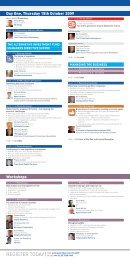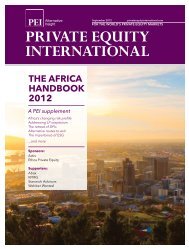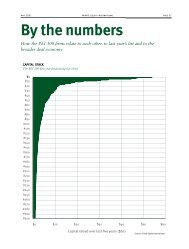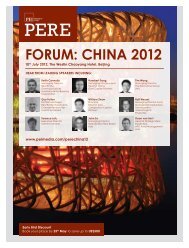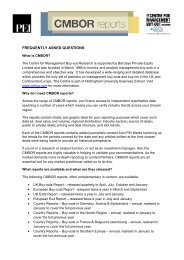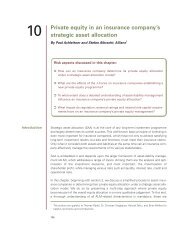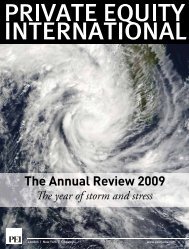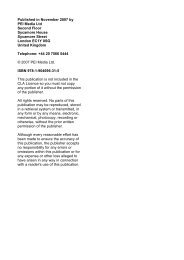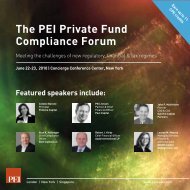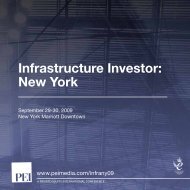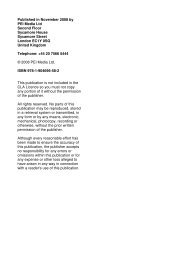THE ANNUAL REVIEW 2010 - PEI Media
THE ANNUAL REVIEW 2010 - PEI Media
THE ANNUAL REVIEW 2010 - PEI Media
Create successful ePaper yourself
Turn your PDF publications into a flip-book with our unique Google optimized e-Paper software.
page 124 private equity annual review <strong>2010</strong><br />
lower fees. Firms that seek to cash in on this growing trend should<br />
be prepared with creative ways to work with LPs. ‘As plan sponsors<br />
get more comfortable with the asset class, they have started<br />
venturing off and doing much more on their own,’ says a fund of<br />
funds source.”<br />
JUNE<br />
Investor relations is a lot about education<br />
“A vital part of a general partner’s job is the education of institutional<br />
investors, even institutions with which the GP has enjoyed<br />
a long relationship. Turnover at institutions like public pensions<br />
is fairly heavy – or at least heavy compared to the long tenure<br />
of the senior executives at some of the world’s biggest private<br />
equity firms. New board members at pensions or foundations<br />
often have no experience with alternative investments, and no<br />
understanding of the long hold periods, say, or the J-curve. Part<br />
of the importance of on-site visits for GPs is being able to answer<br />
questions from these newbies, and possibly dispel some of the<br />
misinformation new board members may bring to the table about<br />
private equity.”<br />
JULY/AUGUST<br />
On the increasingly public US pension board meetings<br />
“In the wake of pension pay-to-play scandals and the financial downturn<br />
that hammered pensions’ private equity portfolio, the big<br />
institutions’ answer has been to open the windows and let the<br />
public see more of what goes on inside. All this openness means<br />
GPs need to be – at the very least – aware they are being recorded<br />
and that members of the public, or the media, can call up their<br />
performances and listen to every word. An interesting side-effect<br />
of this drive for transparency is the potential conflict it creates<br />
with Securities and Exchange Commission rules on private equity<br />
fundraising. ‘Regulation D’ bars managers from soliciting commitments<br />
via an ‘advertisement, article, notice or other communication<br />
in the press’. How the SEC would feel about a GP pitching their<br />
next fund in a live internet broadcast has not yet been tested, but<br />
could prove a contentious issue.”<br />
SEPTEMBER<br />
Throwing good money after bad to rescue a fund<br />
“In deciding whether to invest additional capital to rescue original<br />
commitments, are LPs in fact throwing good money after bad? Is<br />
recapitalising a fund actually worth the financial investment, time<br />
and energy involved or is allowing liquidation the best option<br />
for all? In the case of Fortress, it seems the additional capital<br />
committed by LPs to support investments in the 2004 Fund III<br />
may be paying off. In September, 2009, Fund III was generating<br />
a -1.21 percent internal rate of return. By 31 March <strong>2010</strong>, the<br />
fund was being held at a return multiple of 1.03x and producing<br />
a 1.24 percent IRR.”<br />
OCTOBER<br />
LPs keep the purse strings tight<br />
“Disquiet among investors is not consigned to the rhetoric of<br />
the conference circuit. Developments at two firms over the<br />
summer illustrate how serious LPs are about getting the most<br />
they can from the asset class. Elevation Partners – the mediafocused<br />
firm led by rock star Bono – was recently denied a<br />
fund extension by LPs, while energy-focused firm ArcLight is<br />
finding fundraising tough going, with LPs demanding more distributions<br />
before committing capital to the new fund. ArcLight<br />
raised about $2.1 billion for both its third fund in 2006 and<br />
its fourth fund in 2007. It’s not clear how much ArcLight has<br />
raised for its fifth fund, but sources say the firm is switching<br />
placement agents amid the fundraising. MVision, which was<br />
helping ArcLight raise the fund, is off the assignment, sources<br />
say. The cases of Elevation and ArcLight make clear that limited<br />
partners want to see results before placing more capital with<br />
firms they’ve backed in the past.”<br />
NOVEMBER<br />
On the ILPA guidelines’ first birthday<br />
“The guidelines codified what many LPs had been thinking, and<br />
even asking for, on a more informal basis for years: ideas LPs<br />
have long pursued like cutting back management fees and making<br />
sure those fees were not major profit centres for firms; directing<br />
100 percent of deal fees back to the fund; repaying LPs all<br />
contributed capital plus a preferred return before GPs begin to<br />
receive carried interest. Over the course of the last year, the<br />
guidelines have inspired discussions between LPs and GPs about<br />
fund terms and conditions. Many funds that have come to market<br />
this year have found LPs looking to negotiate on fees and other<br />
terms before making any kind of commitment.”<br />
DECEMBER/JANUARY<br />
How much information can LPs handle?<br />
“LPs, of course, want all the information they can get from GPs.<br />
Details about underlying portfolio companies are vital to help<br />
an LP understand its exposure to various sectors, strategies,<br />
geographies and leverage levels, among other things. In this way,<br />
an LP is not looking at his private equity holdings in terms of<br />
funds or GPs, but in terms of portfolio companies. This level<br />
of detail gives LPs a competitive advantage, participants in our<br />
LP roundtable agreed, but that does not mean it needs to be<br />
communicated to the wider public. For some LPs, however,<br />
this may be more detail than they are ready to accept. Many<br />
institutions invested in the asset class are under-staffed, and<br />
have alternatives teams that are seeing too many PPMs. They<br />
simply don’t have time to really dig into micro-details. Through<br />
due diligence, they figure out which managers to trust with<br />
their capital.” n



